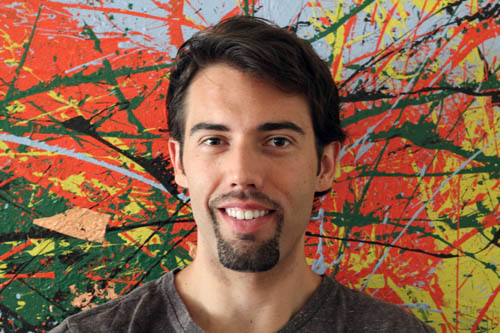
Mike St. John
Tell us a little bit about what you were doing before you came to Columbia.
Hailing from Michigan, I am a born-and-raised Midwesterner. There is an ingrained sense of politeness in this part of the country, a feeling of community, and a shared resilience to any hardships that come a person’s way. Don’t believe me? Let me tell you a little joke we Michiganders love:
There are only two seasons in the Midwest. Can you name them?
Give up? It’s winter and construction.
In all seriousness though, this region is a curious place, and has been my main source of inspiration as an artist and writer. Only now at Columbia College—in both an academic and creative space—have I been able to investigate the elements that constitute this landscape through my writing, sculpture, and performance work. By making such work with academic rigor, I not only find more critical nuance in the place I call home, but more about myself as a human being in the world. Any artist can attest to this cycle of making work to find oneself, and using that new version of oneself to make new work.
With better awareness of how I work comes the ability to widen my scope of why I make the work in the first place. For example, creating sculpture that models the conveyor belts of a cereal factory holds new meaning when I can speak on the rocky socioeconomic status of my hometown of Battle Creek where cereal is produced. I’m not just telling a personal narrative anymore—the art isn’t all me, me, me. It’s about inciting dialogue about bigger issues that we face as a culture.
Why did you choose Columbia for your graduate study?
Coming from a sculpture and creative writing background, I needed an education as diverse as my interests and abilities. I researched a whole host of schools for applications, and I found a sad pattern: the schools fell into either art school or creative writing schools. It was my own personal Sophie’s Choice between the two areas I loved. These schools could not understand that there are creative people out there who work in more than one discipline for their artistic potential.
And then I found Columbia College.
From the start, Columbia had a vibrant magnetism as a creative and educational institution. It is their mission statement to push the boundaries of the traditional artistic fields through collaboration, innovation, and energy. Sculptors, writers, dancers, computer programmers, and actors find their place and their shared community here.
Did I mention that Columbia College is in Chicago? The metropolis of amazing architecture, theater, art scenes, diverse neighborhoods, history, athletic teams, and music festivals? Yes, that very Chicago. Many schools can claim to have artistic communities, but none of them can rival an art epicenter quite like this city.
I found my community in the Interdisciplinary Arts and Media department here at Columbia College. This tight-knit department is mobilized by artists who want to take risks together in research and art-making. InterArts is by definition the in-between of art practices, and never the either-or found in other schools. Collaboration in different media is a must. InterArts has not only pushed me, but revolutionized my way of making art for the better.
That is why I chose Columbia: I chose to be a better, well-rounded artist in all my passions.
Tell us about a project you’re working on that you’re excited about.
My recent work delves into the history of my hometown of Battle Creek, Michigan, cereal capital of the world and the birthplace of Kellogg’s. The cereal boom at the turn of the twentieth century galvanized the spiritual, scientific, industrial, and crackpot theories behind living well in America. This layered history has proven to be a rich territory to explore in sculpture and performance.
The World’s Longest Breakfast Table is my latest project from this research. Every summer, Kellogg’s hosts the Breakfast Table event in downtown Battle Creek, catering everyone with free cereal, milk, fruit, breakfast bars, and entertainment. A social phenomenon occurs at this table—people sit side-by-side to eat, regardless of race, class, or economic status. A community forms around food, however temporary, and brings out the better in the people that come for breakfast.
For my performance work, I created my own World’s Longest Breakfast Table in a black box space. Audience members were free to sit wherever they wanted and I, as perfomer-ethnographer, served them different historical perspectives of Battle Creek—personal, sociological, industrial—along with their cereal and milk. By recreating the communal feeling of the original Battle Creek event, I hoped to make both the distressing and hopeful aspects of my city’s history palatable.
Currently, I am planning new iterations of The World’s Longest Breakfast Table that will be performed in public spaces for larger audiences in Chicago.
